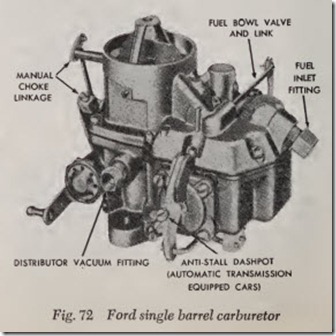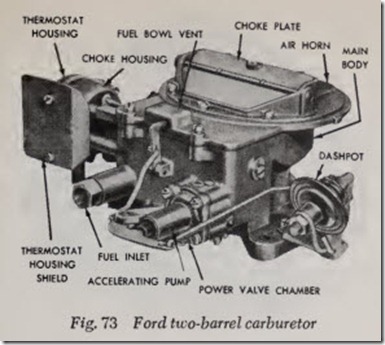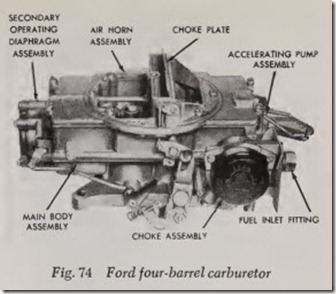Ford Carburetors
ONE-BARREL CARBURETOR
Introduced in 1963 the Ford one-barrel carbu retor, Figs. 71 and 72, consists of two main assem blies, the main (upper) body and the throttle (lower) body.
The upper body contains the major metering components of the carburetor which are: main and idle fuel, power valve, float chamber vent, and fuel inlet systems.
The lower body contains the fuel bowl, acceler ating pump, idle mixture adjusting screw, and spark valve. A hydraulic dashpot is also included in the lower body for use on cars equipped with automatic transmission. The carburetor is avail able with a manual choke or with an automatic choke.
TWO-BARREL CARBURETOR
The Ford two-barrel carburetor, introduced in 1957, consists of two main assemblies: the air horn and the main body, Fig. 73.The air horn assembly, which serves as the main body cover, contains the choke plate and the fuel reservoir vent.
The main body houses the throttle plates, the accelerating pump, the power valve and the fuel reservoir. The automatic choke housing is at tached to the main body.
Each barrel contains a main and booster venturi, main fuel discharge, accelerating pump dis charge, idle fuel discharge and throttle plate.
The carburetor has four basic fuel metering systems. They are the idle fuel system, the ac celerating system, the main fuel system and the power fuel system. A fuel inlet system provides the various fuel metering systems with a constant supply of fuel. In addition, an automatic choke system provides a means of temporarily enriching the mixture to aid in starting and operating a cold engine.
FOUR-BARREL CARBURETOR
This carburetor, Fig. 74, is basically two dual carburetors built into one housing. It consists of two main assemblies: the air horn and the main body.
The air horn assembly, which serves as the main body cover, contains the choke plate and the primary fuel reservoir vent.
The main body houses the primary and secon dary throttle plates, the accelerating pump, the power valve, the secondary operating diaphragm, and the fuel reservoirs. The automatic choke housing is attached to the main body.
The two front (primary) barrels each contain a main and booster venturi, main fuel discharge, accelerating pump discharge, idle fuel discharge, and the primary throttle plate.
The rear (secondary) barrels each have a main and booster venturi, secondary fuel discharge, and a vacuum-operated throttle plate.
The carburetor has a primary fuel circuit and vacuum-operated secondary fuel circuit.
The primary circuit has four basic fuel metering systems. They are the idle fuel system, the ac celerating system, the main fuel system and the power fuel system. A fuel inlet system for both the primary and secondary circuits provides the vari ous fuel metering systems with a constant supply of fuel. In addition, an automatic choke system provides a means of temporarily enriching the mixture to aid in starting and operating a cold engine.



